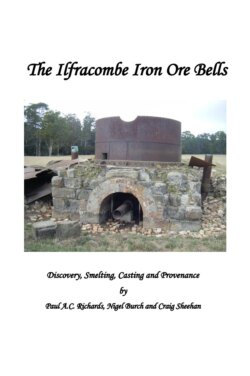The Ilfracombe Iron Ore Bells

Реклама. ООО «ЛитРес», ИНН: 7719571260.
Оглавление
Paul A.C. Richards. The Ilfracombe Iron Ore Bells
FONTIS
Contents Foreword. Introduction. Preface. Acknowledgments. Chapter 1 The Discovery of Hematite at Ilfracombe & Mt Vulcan, West Tamar. Chapter 2 The History of Blast Furnaces. Chapter 3 Establishment of the Ilfracombe Iron Company. Chapter 4 Quality of Iron Ore and Smelting Foundries. Chapter 5 Casting of the Ilfracombe Bells. Chapter 6 Melbourne, London and Vienna Exhibition 1873. Chapter 7 Provenance of the Ilfracombe Bells. Chapter 8 Re-casting an Ilfracombe Iron Bell 2017 About. About the Authors
Foreword
Introduction
Preface
Acknowledgments
Chapter 1: The Discovery of Hematite at Ilfracombe & Mt Vulcan, West Tamar
ILFRACOMBE IRON ORE DEPOSITS
EQUIPMENT INSTALLED
RESULTS UNSATISFACTORY
Hematite samples – Ilfracombe
Chapter 2: The History of the Blast Furnace
Chapter 3: Establishment of the Ilfracombe Iron Company
Chapter 4: Quality of Iron Ore and Smelting Foundries
Chapter 5: Casting of the Ilfracombe Bells
Chapter 6: Victorian 1872, London and Vienna Exhibition 1873
Chapter 7: Provenance of the Ilfracombe Bells
Chapter 8: Casting an Ilfracombe Iron Ore Bell
Castings Tasmania
Patternmaking
ABOUT THE AUTHORS
Отрывок из книги
Design and Pattern Making
The Ilfracombe Iron Ore Bell
.....
In conclusion the Ilfracombe Iron Company 1872-5 near Beaconsfield failed on start-up because their blast engine (air compressor) was not up to the task, though they claimed to have produced a batch of good quality charcoal pig iron from Peaked Hill ore in their first blast. They had replaced their waterwheel with a small steam engine to provide the blast, but found it was too small and bought a larger engine from Melbourne. That was still too small and after spending nearly £10,000, they had run out of money to buy another. Their bank foreclosed. Two of the shareholders, Adye Douglas and James White bought out the assets for £805 in a rather suspect sale, but with the prevailing low iron prices decided not to reopen. If the Tasmanian government had given an incentive for iron production, similar to the other colonies, it would have paid for the new blast engine and likely ensured the survival of the company. There was no chromium in their iron load.
Source: P.A.C. Richards collection 2017
.....